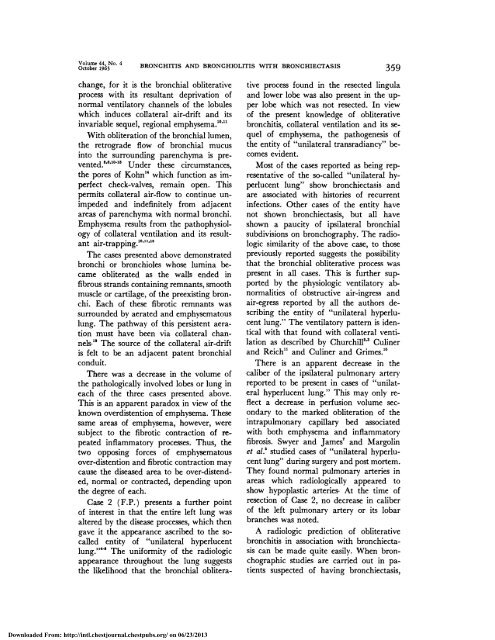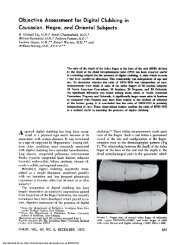Obliterative Bronchitis and Bronchiolitis with Bronchiectasis*
Obliterative Bronchitis and Bronchiolitis with Bronchiectasis*
Obliterative Bronchitis and Bronchiolitis with Bronchiectasis*
You also want an ePaper? Increase the reach of your titles
YUMPU automatically turns print PDFs into web optimized ePapers that Google loves.
44 No.<br />
October l9k3<br />
BRONCHITIS AND BRONCHIOLITIS WITH BRONCHIECTASIS 359<br />
change, for it is the bronchial obliterative<br />
process <strong>with</strong> its resultant deprivation of<br />
normal ventilatory channels of the lobules<br />
which induces collateral air-drift <strong>and</strong> its<br />
invariable sequel, regional<br />
With obliteration of the bronchial lumen,<br />
the retrograde flow of bronchial mucus<br />
into the surrounding parenchyma is pre-<br />
~ented.'~"~-~~ Under these circumstances,<br />
the pores of Kohn14 which function as imperfect<br />
check-valves, remain open. This<br />
permits collateral air-flow to continue unimpeded<br />
<strong>and</strong> indefinitely from adjacent<br />
areas of parenchyma <strong>with</strong> normal bronchi.<br />
Emphysema results from the pathophysiology<br />
of collateral ventilation <strong>and</strong> its resultant<br />
air-trapping.'O"'"S<br />
The cases presented above demonstrated<br />
bronchi or bronchioles whose lumina became<br />
obliterated as the walls ended in<br />
fibrous str<strong>and</strong>s containing remnants, smooth<br />
muscle or cartilage, of the preexisting bronchi.<br />
Each of these fibrotic remnants was<br />
surrounded by aerated <strong>and</strong> emphysematous<br />
lung. The pathway of this persistent aeration<br />
must have been via collateral channels.''<br />
The source of the collateral air-drift<br />
is felt to be an adjacent patent bronchial<br />
conduit.<br />
There was a decrease in the volume of<br />
the pathologically involved lobes or lung in<br />
each of the three cases presented above.<br />
This is an apparent paradox in view of the<br />
known overdistention of emphysema. These<br />
same areas of emphysema, however, were<br />
subject to the fibrotic contraction of repeated<br />
inflammatory processes. Thus, the<br />
two opposing forces of emphysematous<br />
over-distention <strong>and</strong> fibrotic contraction may<br />
cause the diseased area to be over-distended,<br />
normal or contracted, depending upon<br />
the degree of each.<br />
Case 2 (F.P.) presents a further point<br />
of interest in that the entire left lung was<br />
altered by the disease processes, which then<br />
gave it the appearance ascribed to the socalled<br />
entity of "unilateral hyperlucent<br />
lung."48 The uniformity of the radiologic<br />
appearance throughout the lung suggests<br />
the likelihood that the bronchial oblitera-<br />
Downloaded From: http://intl.chestjournal.chestpubs.org/ on 06/23/2013<br />
tive process found in the resected lingula<br />
<strong>and</strong> lower lobe was also present in the upper<br />
lobe which was not resected. In view<br />
of the present knowledge of obliterative<br />
bronchitis, collateral ventilation <strong>and</strong> its sequel<br />
of emphysema, the pathogenesis of<br />
the entity of "unilateral transradiancy" becomes<br />
evident.<br />
Most of the cases reported as being representative<br />
of the so-called "unilateral hyperlucent<br />
lung" show bronchiectasis <strong>and</strong><br />
are associated <strong>with</strong> histories of recurrent<br />
infections. Other cases of the entity have<br />
not shown bronchiectasis, but all have<br />
shown a paucity of ipsilateral bronchial<br />
subdivisions on bronchography. The radiologic<br />
similarity of the above case, to those<br />
previously reported suggests the possibility<br />
that the bronchial obliterative process was<br />
present in all cases. This is further supported<br />
by the physiologic ventilatory abnormalities<br />
of obstructive air-ingress <strong>and</strong><br />
air-egress reported by all the authors describing<br />
the entity of "unilateral hyperlucent<br />
lung." The ventilatory pattern is identical<br />
<strong>with</strong> that found <strong>with</strong> collateral venti-<br />
lation as described by Ch~rchill~~~ Culiner<br />
<strong>and</strong> Reich" <strong>and</strong> Culiner <strong>and</strong> Grimes.''<br />
There is an apparent decrease in the<br />
caliber of the ipsilateral pulmonary artery<br />
reported to be present in cases of "unilat-<br />
eral hyperlucent lung." This may only re-<br />
flect a decrease in perfusion volume sec-<br />
ondary to the marked obliteration of the<br />
intrapulmonary capillary bed associated<br />
<strong>with</strong> both emphysema <strong>and</strong> inflammatory<br />
fibrosis. Swyer <strong>and</strong> James7 <strong>and</strong> Margolin<br />
et al.' studied cases of "unilateral hyperlu-<br />
cent lung" during surgery <strong>and</strong> post mortem.<br />
They found normal pulmonary arteries in<br />
areas which radiologically appeared to<br />
show hypoplastic arteries. At the time of<br />
resection of Case 2, no decrease in caliber<br />
of the left pulmonary artery or its lobar<br />
branches was noted.<br />
A radiologic prediction of obliterative<br />
bronchitis in association <strong>with</strong> bronchiecta-<br />
sis can be made quite easily. When bron-<br />
chographic studies are carried out in pa-<br />
tients suspected of having bronchiectasis,




